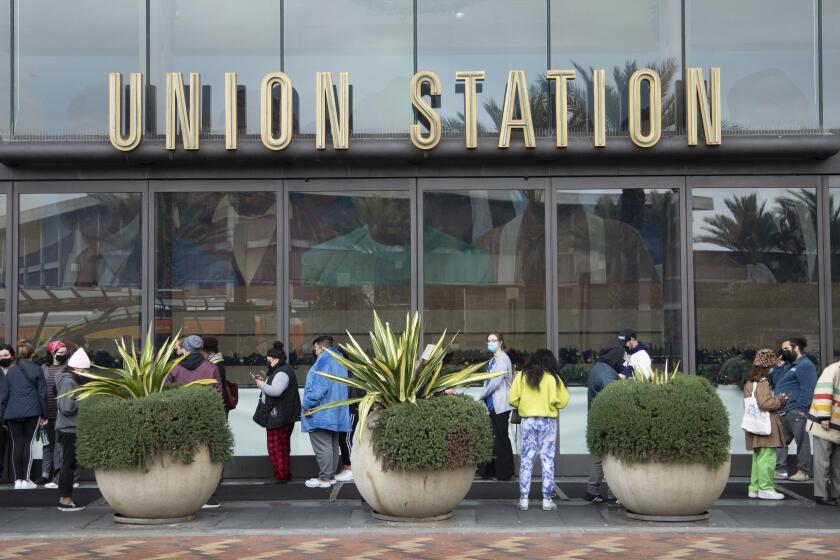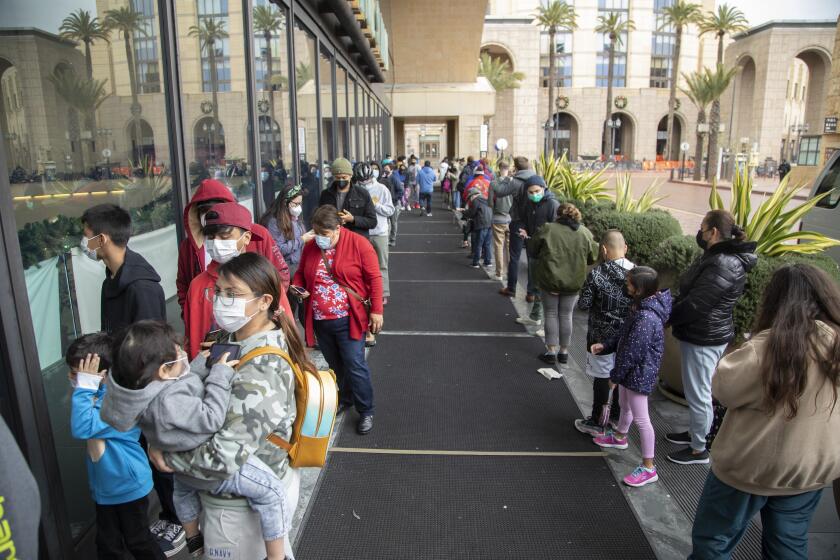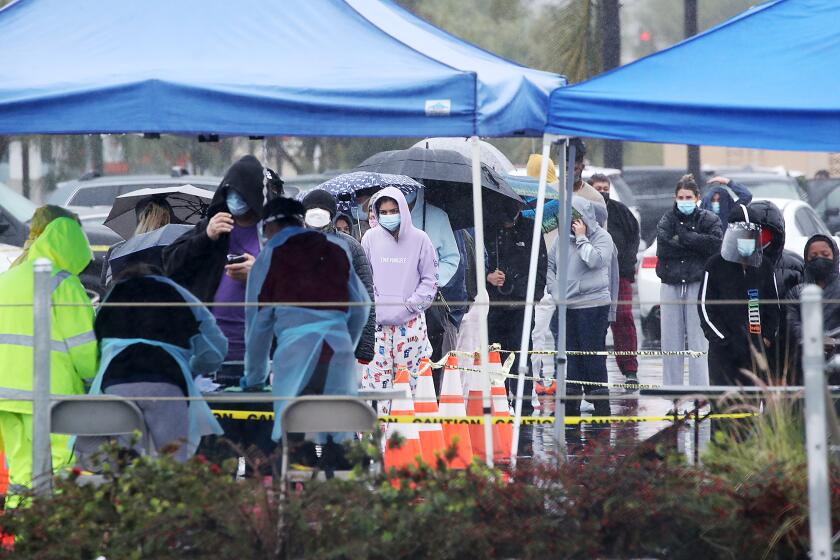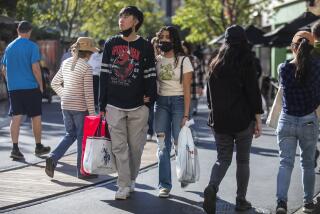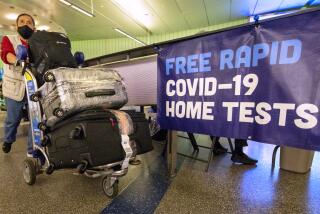Coronavirus wave slams California as L.A. County reports 20,000 new cases
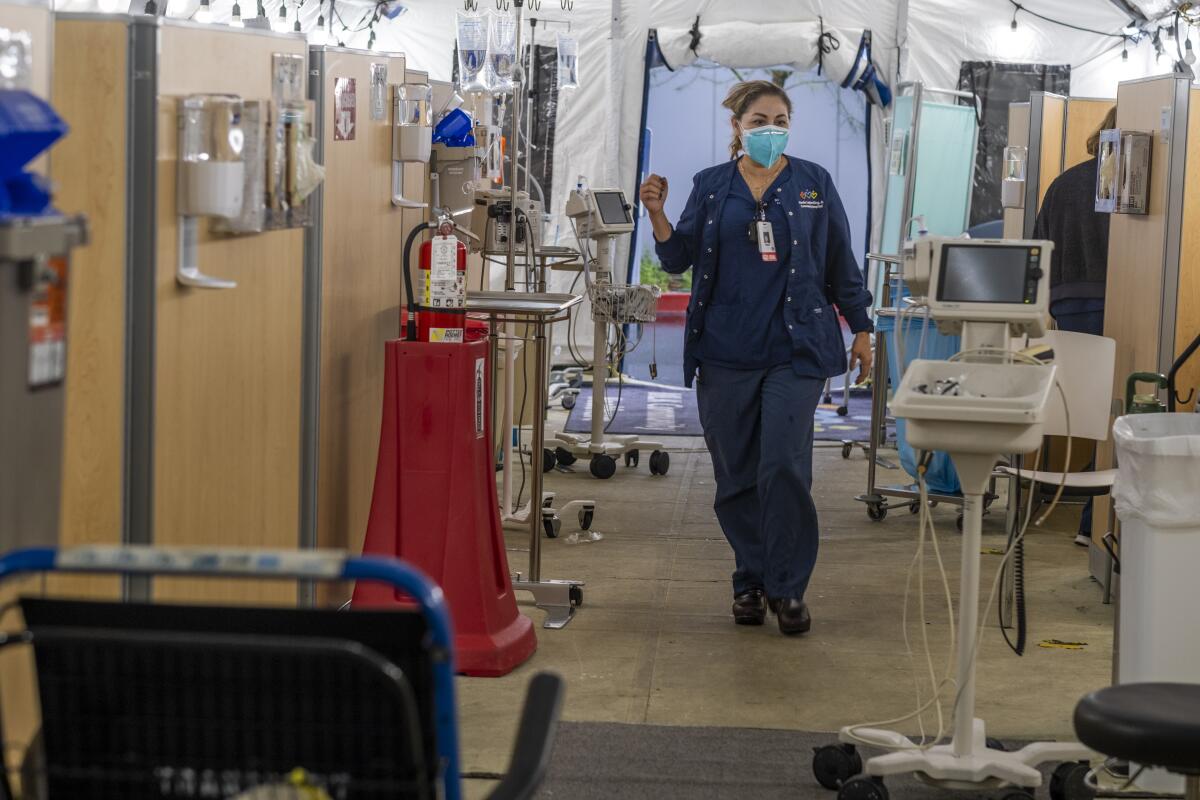
- Share via
The long-feared winter coronavirus wave reached new heights Thursday as Los Angeles County reported more than 20,000 new cases, fueled in part by the highly transmissible Omicron variant that is washing over the region.
Overall, California’s reported average daily coronavirus caseload has more than quadrupled in the last two weeks — an astonishing rise that has pushed infection levels significantly higher than at any point during the summer surge.
“We are, in fact, experiencing the worst of a surge at the moment with the rising number of cases,” L.A. County Public Health Director Barbara Ferrer told reporters.
Thursday’s total in L.A. County, 20,198, is one of the highest in the pandemic. Over the last two days, the nation’s most populous county has announced nearly 37,000 new cases.
“The risk for virus transmission has never been higher in our county,” Ferrer said.
Soaring COVID-19 cases fueled by the fast-spreading Omicron variant are prompting fresh concerns about end-of-year gatherings.
Despite the ballooning infections, far fewer COVID-19 patients are hospitalized than during either of the last two waves, and health officials appear increasingly optimistic that symptoms in cases linked to the highly transmissible Omicron variant may be less severe than other versions of the coronavirus.
But the recent near-vertical trend line underscores the rampant spread of the virus and has prompted increasingly urgent calls for caution from health officials who worry that hospitals may be slammed by a new crush of patients if transmission remains this high.
L.A. County is far from alone in contending with a new crush of infections.
“While we don’t yet know exactly how the severity of Omicron compares with the severity to other variants … our case rates are going up incredibly fast, and some proportion of people that get sick will require a hospital bed,” said Dr. Sara Cody, the public health director and health officer for Santa Clara County.
Over the weeklong period ending Wednesday, California announced an average of 23,637 new coronavirus cases per day, according to data compiled by The Times. Two weeks earlier — during the week ending Dec. 15 — the average was 5,792 per day.
The summertime spike peaked at a bit more than 15,000 new cases per day. During the worst days of last winter, however, the daily average case count was closer to 45,000.
Officials say the latest wave is probably fueled by a few factors, including increased travel and gatherings for the winter holidays and breakneck proliferation of Omicron — which has mushroomed rapidly statewide since its presence was first confirmed at the start of the month.
As of Monday, Omicron had been identified in 3,515 specimens statewide, according to the California Department of Public Health. That’s a significant rise from the 460 Omicron cases that had been confirmed by Dec. 22.
The warnings come as the nationwide number of newly confirmed COVID-19 infections roared to a record high and hospitalizations in California and elsewhere continue to increase.
While it’s not yet known for certain whether Omicron has become the state’s dominant circulating coronavirus variant, its rapid spread is concerning, officials said.
“Over the last nearly two years, there have been surges in COVID-19 cases associated with new variants, seasonality and changes in public behavior,” officials wrote in a statement to The Times. “We are currently bracing for the impact of the Omicron variant in California.”
Officials say residents can still best protect themselves by getting vaccinated and boosted, if eligible, and by taking precautions — like avoiding crowded settings, wearing masks indoors while in public and self-testing just before showing up to a gathering.
Unvaccinated Californians are 5.2 times more likely to get COVID-19, 14.5 times more likely to be hospitalized and 15 times more likely to die from the disease, according to the latest figures from the state Department of Public Health.
“While we have explosive increases in cases, indicating very high community transmission, we do need to continue to use every single tool we have to protect ourselves and each other,” Ferrer said. “Vaccination and booster doses are still extraordinarily powerful tools to reduce your risk of infection and particularly to reduce your risk of getting seriously ill.”
The winter spread of coronavirus cases is worsening. Here’s the latest advice on protecting yourself and those around you.
Even before Omicron stormed onto the scene, officials were warning that winter’s arrival would present additional dangers — as a packed social calendar and cooler temperatures would increasingly tempt Californians to gather indoors, where the risk of transmission is generally higher.
Supervisor Holly Mitchell, chairwoman of the L.A. County Board of Supervisors, urged residents to “please rethink your New Year’s Eve plans.”
“Large gatherings are probably not in our individual or collective best interest this year,” she said during a briefing Thursday. “I want you to all think about the impact your individual actions really could have on both our healthcare workers and our healthcare infrastructure.”
In Sonoma County, health officials said Wednesday that holiday gatherings accounted for 40% of new COVID-19 cases where the source of infection was known.
“Throughout the pandemic, we have seen cases spike around holidays as people gather to celebrate with loved ones,” county Health Officer Dr. Sundari Mase said in a statement. “Let’s start the new year on the right foot by staying safe and avoiding outbreaks.”
San Diego County health officials urged residents to keep New Year’s celebrations small and limited to family and close friends who are vaccinated and boosted if eligible.
“We get it. People are tired of the pandemic, but given the record number of cases, the brisk emergence of Omicron and the increased risks that come with gatherings, San Diegans must continue to make decisions to protect themselves and others,” Dr. Cameron Kaiser, the county’s deputy public health officer, said in a statement Thursday.
If gathering with others from outside their household, residents should wear masks and limit indoor activities, Kaiser said. Anyone who develops COVID-19 symptoms should stay home and get tested, regardless of their vaccination status, and isolate themselves until they test negative and feel better.
While not as high as earlier in the pandemic, the daily COVID-19 patient tally has soared statewide recently.
The statewide number rose to 5,107 Wednesday, the highest since late September and an increase of 41% in the last week.
It’s unclear whether Delta or Omicron is the primary culprit behind the recent rise, but COVID-19 hospitalizations have ballooned by 60% since the start of the month — when the latter’s presence was first officially confirmed in California.
Already, some systems are feeling the strain. San Diego County emergency departments saw such a significant increase in traffic Wednesday that the region’s emergency medical director issued a special alert just after 1 p.m.
About half of the 22 hospitals in the area were so busy they had to divert ambulances to other facilities, a common practice designed to give overburdened medical staffs time to catch up with crushing demand. The spike appeared to be tied, in part, to a demand for testing.
“If emergency departments are on diversion, then ambulances have to drive farther away and they’re less available to respond to 911 calls, which puts the whole system at risk,” said Dr. Kristi Koenig, medical director of San Diego County’s emergency medical system. “It’s not a good situation, one that we try to prevent whenever we can.”
Staffing is another concern — especially as healthcare workers contend with burnout or are stricken with COVID-19 or other respiratory illnesses themselves.
In Orange County, “What I’m hearing on the ground, anecdotally, from clinics and healthcare systems is they’re seeing anywhere from 10[%] to 15% of their healthcare force being affected by some sort of illness,” said Dr. Regina Chinsio-Kwong, a county deputy health officer.
“This is being experienced nationwide, so even trying to get extra resources from elsewhere, it’s going to be very difficult to get extra nurses or physicians or healthcare staff because everybody is experiencing this together,” she said Thursday.
The rapid increase in COVID cases reflects ‘the exceptionally transmissible’ quality of the Omicron variant, CDC director Dr. Rochelle Walensky says.
However, there are promising signs that infections linked to Omicron are milder than those associated with the Delta variant.
In recent reports from Scotland, the risk of hospitalization with Omicron was 66% lower than in previous waves, according to Dr. Anthony Fauci, the White House’s top medical advisor. And South Africa reported that, among patients who did end up in the hospital, they stayed an average of four days, compared with 8.8 days during the Delta wave.
While Omicron’s full impact in the U.S. remains to be seen, “all indications point to a lesser severity of Omicron versus Delta,” Fauci said during a briefing Wednesday.
“It is difficult to determine what degree of lessened severity is due to preexisting immunity, or the intrinsically lower virulence of Omicron ... or a combination of both,” he said during a briefing.
Even a less-severe variant, officials note, could still have devastating consequences as case numbers soar.
“Increased transmissibility of Omicron resulting in an extremely high volume of cases may override some of the impact of the lower disease severity,” Fauci said. “And so we should not become complacent, since a hospital system could still be stressed in certain areas of the country.”
While officials acknowledge that the chance of post-vaccination “breakthrough” cases is higher with Omicron, the risk of infection — and especially for serious health consequences — has remained higher for those who are unvaccinated.
The San Diego Union-Tribune and Times staff writers Sean Greene, Rong-Gong Lin II, Anumita Kaur and Gregory Yee contributed to this report.
More to Read
Sign up for Essential California
The most important California stories and recommendations in your inbox every morning.
You may occasionally receive promotional content from the Los Angeles Times.
